
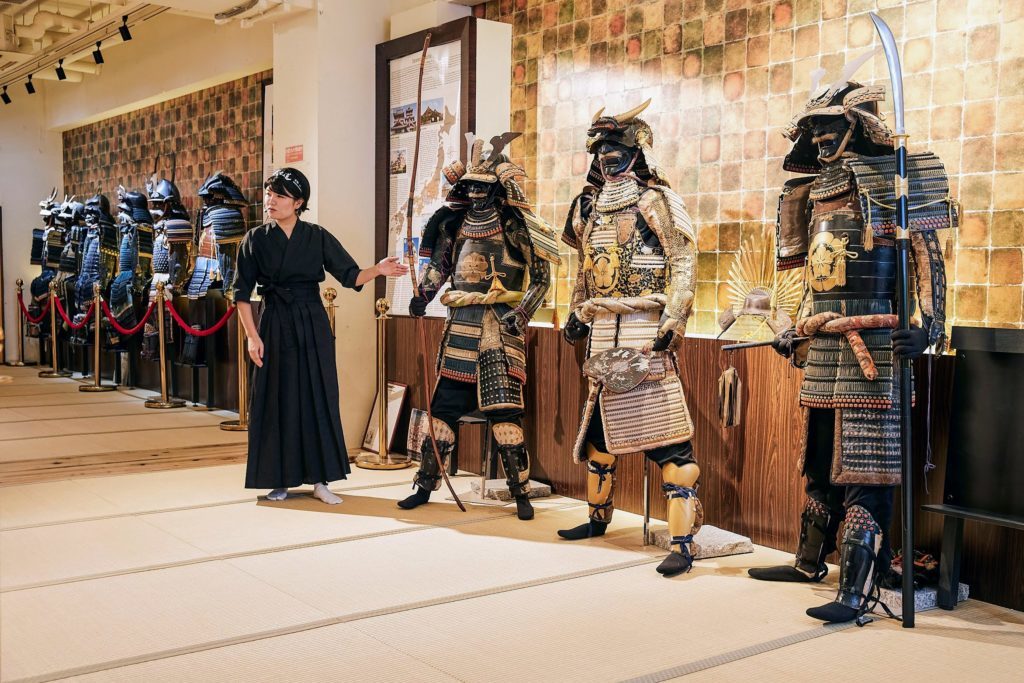
samurai & ninja museum
The samurai were a class of warrior nobility who followed the Bushido code and shaped the history of Japan. The most famous are the Three Great Unifiers: Oda Nobunaga, Toyotomi Hideyoshi, and Ieyasu Tokugawa. There were many well-known samurai besides these three, from Tomoe Gozen who was a female samurai admired for her skills with the sword, to the black samurai Yasuke who served as a bodyguard to Nobunaga.
These warriors became the ruling power in the country for centuries, different from that of the ninja or shinobi who were covert agents or mercenaries that existed around the same time in feudal Japan.
Content
Famous Samurais
Oda Nobunaga (1534~1582), The First Great Unifier of Japan
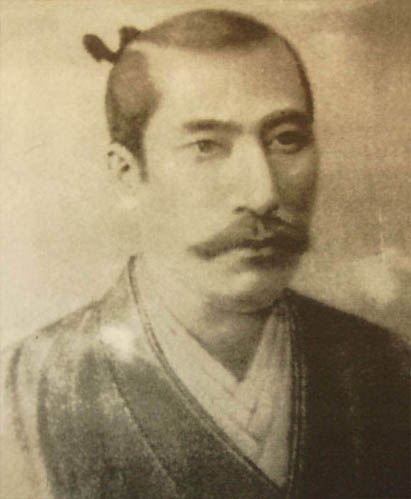
After the Onin War in 1467-1477, the feudal system collapsed as all the daimyos or feudal lords declared independence, dominating each other on their quest for more power. This was referred to as the Warring States Period or the Sengoku Period.
The situation, however, was brought to heel by the Demon King, Oda Nobunaga, a samurai leader who was born in 1534 in the Owari Province, where the Nagoya Castle stands.
Oda Nobunaga was said to be unpredictable and displayed bizarre, even disrespectful behavior as a teenager. One incident was during his father, Oda Nobuhide’s funeral where he displayed such contempt that one of the clan retainers committed seppuku or ritual suicide out of shame and disapproval.
After his father’s death, Oda Nobunaga was rightfully meant to take over as head of the Oda clan but this was put on hold by the internal power struggle as his uncle and younger brother wanted to position as well. To take over as the clan, he had to eliminate his competition–first, he killed his uncle, followed by his younger brother.
Following these events, Oda Nobunaga attacked an army of 25,000 men from the rival Imagawa clan with only 3000 men, disregarding the warnings from his advisors. He made use of dummy soldiers in the dark to intimidate his enemies and then ambushed them in a narrow gorge.
In 1568, the Ashikaga Shogun enlisted Nobunaga and brought him to Kyoto as protection from other daimyos. They started as allies but Nobunaga eventually restricted the powers of the Ashikaga Shogun and gained control. Historians call this moment the end of the Muromachi (Ashikaga) period and the beginning of the period of Azuchi-Momoyama.
Despite his many victories, his brother, one of his brothers was killed by the Ikko-Ikko warrior monks, a group of religious rebels whom Oda Nobunaga has lost to a number of times. The group’s constant uprisings against Nobunaga’s reign led him to launch a siege in 1571 and burn down one of the biggest temples in Japan, slaughtering thousands of monks, laymen, women, and children in Mount Hiei in the north of Kyoto City. This earned him the title of Demon King or Demon Daimyo.
He repeated this in 1574, burning the Nagashima settlements of the Ikko-Ikko, taking the lives of about 20,000 people.
In 1575, Oda Nobunaga’s forces crushed the Takeda clan’s army (famous for its cavalry) by using arquebuses that Nobunaga acquired from Westerners. About 10,000 Takeda warriors were killed near the Nagashino Castle. Although the leader of the Takeda clan survived, Nobunaga claimed all of their territories in 1582.
Nobunaga was known to have an interest in European culture, becoming a patron of the Jesuit missionaries, introducing and promoting Christianity in Japan. Some historians even claim that he converted to Christianity.
In 1578, Oda Nobunaga built the Azuchi Castle, the biggest and perhaps the most aesthetically pleasing castle at the time. This great structure was built on a hill that oversees Eastern and Western Japan.
However, the problem in Central Japan was the ninja clans in the Iga region. The ninjas were completely independent mercenaries who were hired as spies. The ninjas defeated Nobunaga’s son, Oda Nobuo, in 1579. The Oda clan took their revenge in 1581, surrounding the Iga region with an overwhelming 44,000 warriors, ending the ninja independence.
Nobunaga also was sometimes disrespectful to men around him. He called Toyotomi Hideyoshi Saru (Monkey) and Akechi Mitsuhide Hage (baldy). He also killed some high-ranking war prisoners, whose relatives, in turn, killed Akechi’s mother.
On June 21, 1582, while having a tea ceremony at the Honnoji Temple with a few dozen servants, Nobunaga was surrounded by thousands of samurai troops waiting outside to kill him.
To avoid capture, Oda Nobunaga committed seppuku and ordered his servants to set the temple on fire. These samurai troops were led by no-one else but Akechi Mitsuhide, one of Nobunaga’s closest generals.
Toyotomi Hideyoshi (1537~1598), The Second Great Unifier of Japan
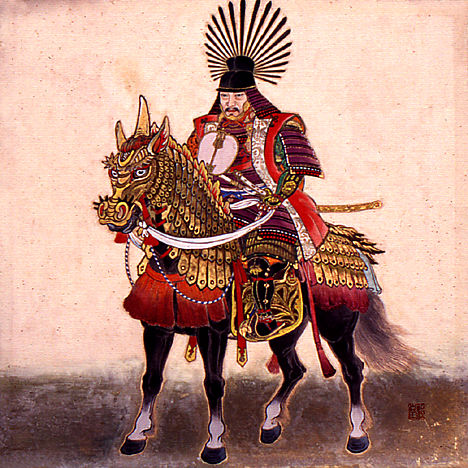
Toyotomi Hideyoshi had a rags-to-riches story that started from being the son of a peasant and was a sandal bearer for Oda Nobunaga. He proved himself to be a smart and good warrior, becoming one of Nobunaga’s greatest generals. He avenged his master just 11 days after his death and killed Akechi Mitsuhide.
The chiefs from the Oda clan opposed the idea of Hideyoshi taking the position of his former master as he was not part of the Oda family. To fix this, Hideyoshi appointed the infant son of Nobunaga as the new leader on purpose and then destroyed the forces of Katsuie, the chief of the Oda clan. Later he declared himself the head of the Oda clan and started ruling the largest territory in Japan.
In 1583, Hideyoshi ordered the construction of the largest castle in Japan at the time: the Osaka Castle. The daimyos from each region competed with each other, carrying large stones to use for the castle, as a sign of their loyalty to Hideyoshi.
In the following years, Hideyoshi conquered the Shikoku island and Kyushu island, and the Odawara Castle in Edo, modern-day Tokyo, in 1590. These actions led to the fulfillment of Nobunaga’s goal to unify Japan under one rule – and was nonetheless achieved by the son of a peasant.
Despite his achievements, the emperor did not appoint Hideyoshi as the shogun since he did not belong to the Minamoto clan.
Hideyoshi created a law in 1586 as a grand minister that prohibited anyone besides the samurai from carrying weapons, confiscating the swords, and melting them into a Buddha statue. He was also against Christianity, killing 26 missionaries and Japanese converts in Nagasaki to discourage more conversions.
Hideyoshi also asked Sen no Rikyu, the founder of the tea ceremony and one of Hideyoshi’s closest friends, to commit seppuku, for the reason we still don’t know today.
Toyotomi Hideyoshi launched invasions to take China through the Korean Peninsula in 1592 and 1597. Both campaigns, although were successful in taking over the peninsula, never made it to Mainland China. The routes that were taken at the time, however, were utilized in 1931 during the Japanese occupation of Korea.
Hideyoshi did not have a child to take over after him so he appointed his nephew as his heir. but He eventually had a son 5 years before his death in 1598. To ensure that his son would rule, he killed his nephew and many of his family members, including the women and children.
Before he died, he set up the Council of Five Elders to rule Japan temporarily until his 5-year-old son grows up. The council, consisting of 5 generals including Ieyasu, promised to protect his son and obey his rule in the future.
Musashi Miyamoto (1584~1645)
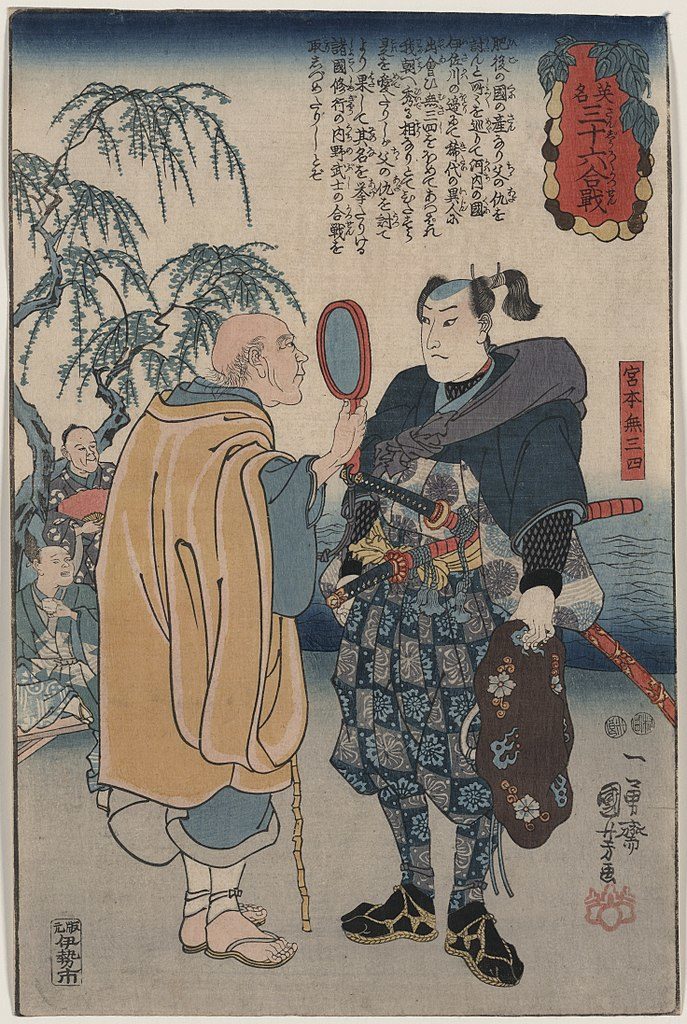
Musashi did not have a master daimyo so he was a ronin. He had more than 60 sword duels, the highest number recorded. He is said to have killed 17 people in his battles. His first battle was when he was 13. He was a very strong and skilled carpenter, architect, and artist. He was about 180 cm while an avg. samurai was 150 cm tall. He is famous for his technique of using two swords in his two hands as usually katana is held with both hands. He wrote a book to train the samurais and the swordsmen. The book is recommended to everyone including martial arts practitioners and business leaders. Miyamoto emphasized that the techniques are less important than the overall goal. The same fighting principles apply to not only one-on-one conflicts but also army battles.
The 5 rings represent the five episodes Musashi wrote:
“Do nothing that is of no use”; “If you wish to control others you must first control yourself”; “from one thing, know ten thousand things”; “It is difficult to understand the universe if you only study one planet”; “In battle, if you make your opponent flinch, you have already won.”; “Do not regret what you have done”; “If you do not control the enemy, the enemy will control you”; “Respect Buddha and the gods without counting on their help”; “The important thing in strategy is not to suppress the enemy’s useful actions but allow his useless actions”; “Perception is strong and sight weak. In strategy, it is important to see distant things as if they were close and to take a distanced view of close things.”; “Accept everything just the way it is.”; “Never let yourself be saddened by a separation.”
Sanada Yukimura (1567- 1615)
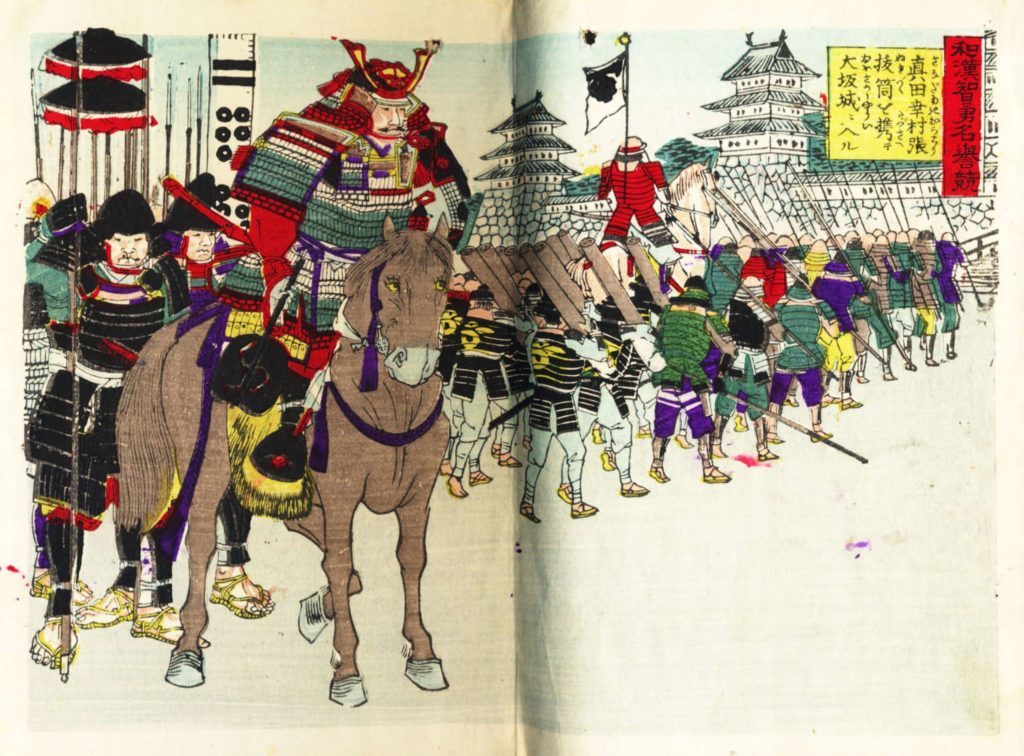
Sanada Yukimura was the most famous samurai of the Sanada clan, being called “A Hero who may appear once in a hundred years“ and “Number one warrior in Japan,“ who is famous for his participation in the Siege of Osaka Castle in 1614 (Winter campaign) and 1615 (Summer Campaign). In the events preceding the Battle of Sekigahara, Yukimura and his father decided to side with Ishida Mitsunari, against Tokugawa Ieyasu, parting ways with Yukimura’s brother Nobuyuki. He participated in the Winter and Summer sieges of Osaka Castle, successfully defending the Castle with only 6000 men against the Tokugawa shogunate attacked by 30,000 troops. He was killed near the Yasui Shrine right by the Tennoji temple in Osaka during the Summer Siege of Osaka castle. His armor had a symbolic meaning: deer horns (deers are messengers of Gods), red color (red is the purifying color that keeps evil spirits away, 6 coins (after death our spirits should pay 6 coins to the devil waiting by the river, the 6 coins on the helmet to remind the readiness for death).
Yoshitsune Minamoto (1159-1189)
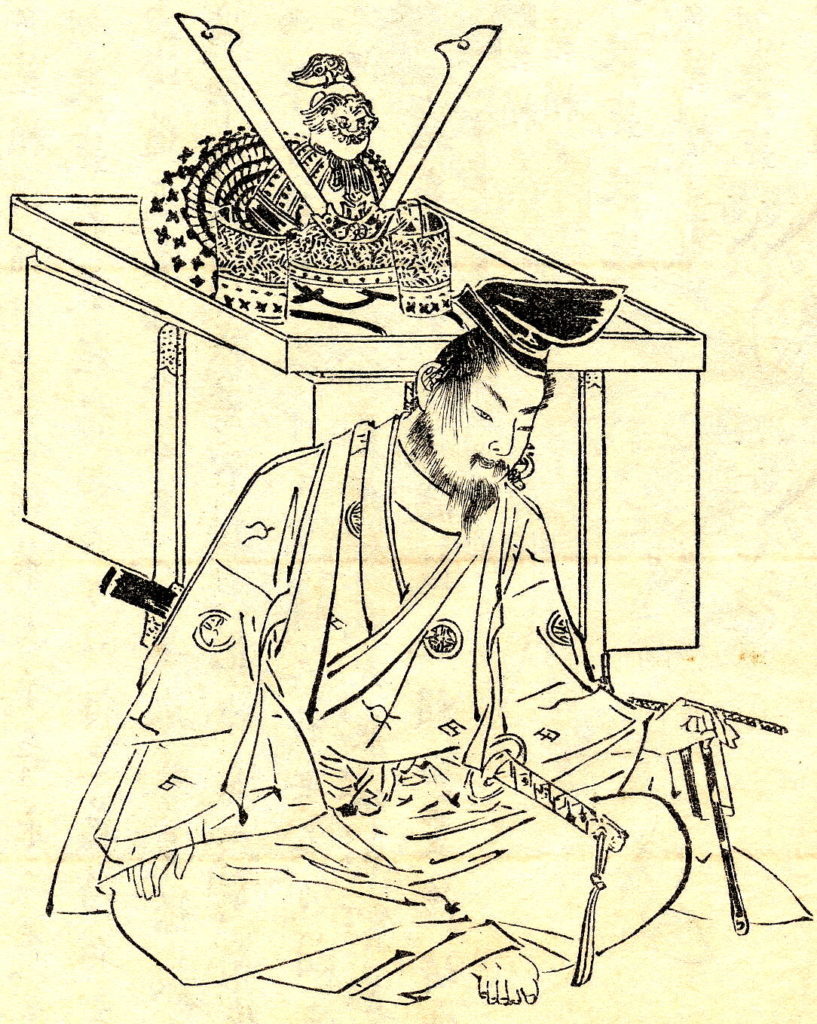
Yoshitsune Minamoto faced hardship already as a 1-year-old boy when his father and two older brothers were murdered in the Heiji Rebellion, while he and his mother managed to flee. He was raised by the monks in Kurama Temple but did not want to become a priest himself. His famous companion was Benkei (1155-1189) who was sohei ( warrior monk). One night, Benkei was wandering around Kyoto, in his quest to take 1000 swords from samurai warriors. Having managed to make 999 swords, he faced up to the man much smaller than himself and lost- that man was Yoshitsune Minamoto. Out of respect, he became Yoshitsune’s retainer and fought alongside him in his battles against the Taira clan, becoming known in Japanese folklore for his honor, bravery, and loyalty. When Yoshitsune was betrayed by his brother Yoritomo and had to commit seppuku (ritual suicide) in the castle of Koromogawa, Benkei died defending him, pierced by a barrage of arrows on the bridge leading towards the castle.
Takeda Shingen (1521- 1573)
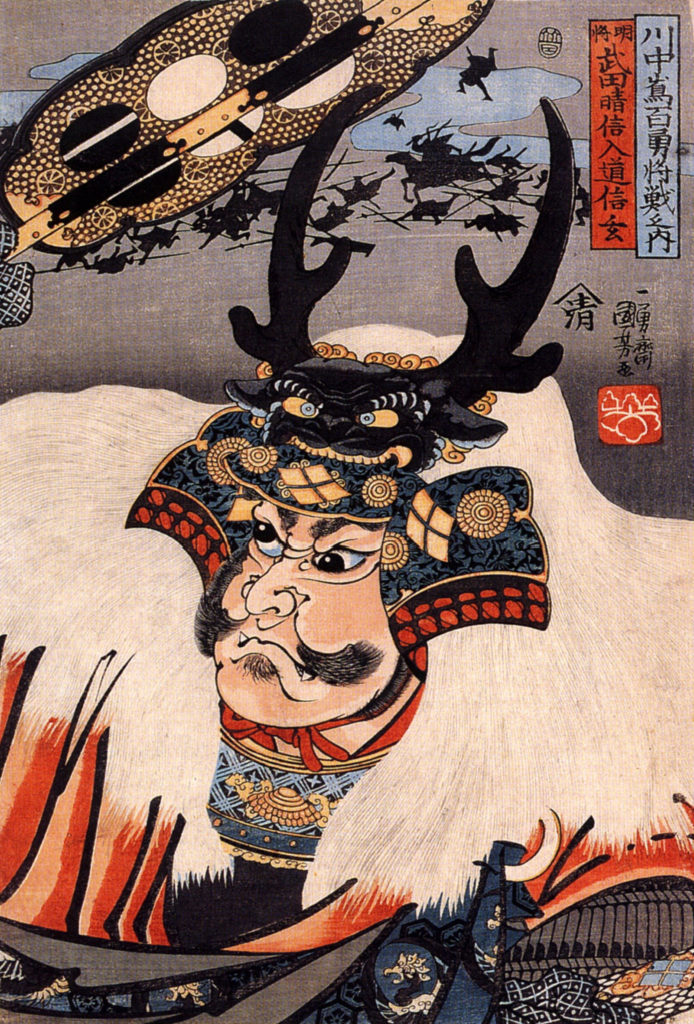
Takeda Shingen, Haronubu, was one of the most famous feudal lords of Japan, during a difficult Sengoku (warring states) period. He was known for his rivalry with another famed warrior Uesugi Kenshin. Born into a clan of military governors, he forced his father to step down as a head of the clan and took over. He started expanding into neighboring areas, acquiring a lot of land for his family. In 1551, he became a Buddhist priest and took the name Shingen. Around that time, he started his rivalry with Uesugi Kenshin, with whom he fought five times in the Battles of Kawanakajima. During the only single combat between the two, Kenshin attacked him with a sword, while Shingen fought back with an iron war fan. He also defeated Tokugawa Ieyasu in the Battle of Hamamatsu. There are many accounts of his death, but the most popular is offered in Kurosawa’s movie “Kagemusha“, according to which he died of a single sniper shot wound.
Yoritomo Minamoto (1147-1199)
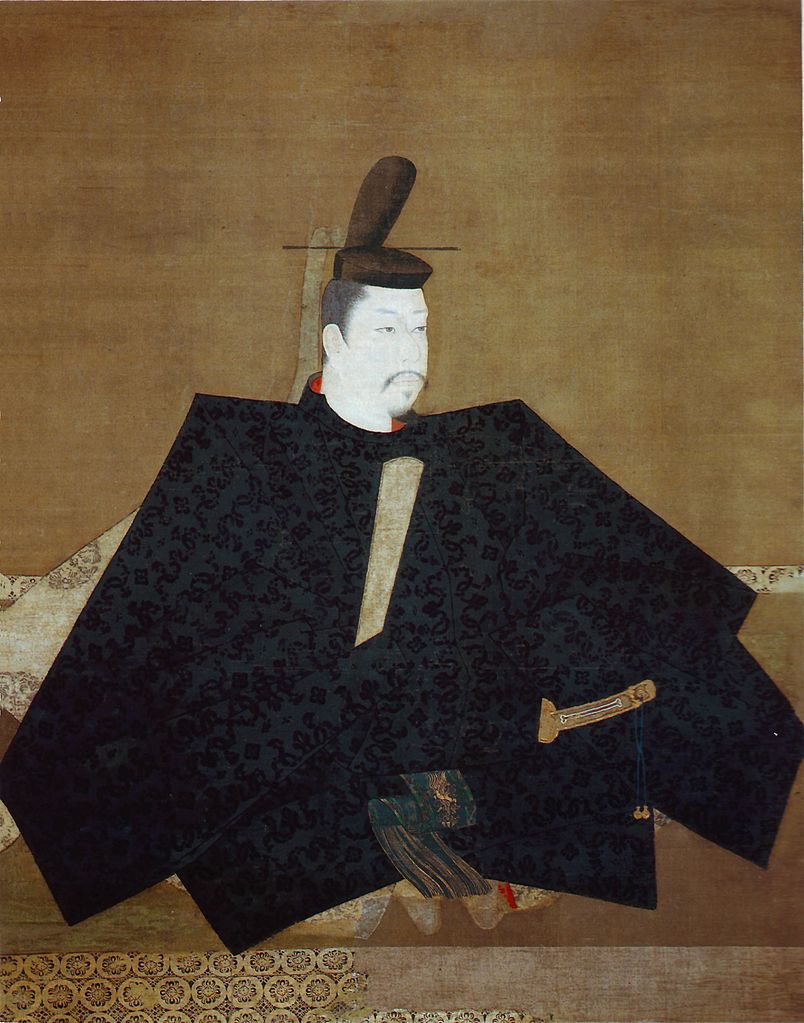
Yoritomo Minamoto is one of the most important historical figures in Japan, being the first shogun of the Kamakura shogunate, the first shogunate in Japan’s history. As a member of the Minamoto clan, he was destined for a clash with the rival Taira clan. His father and numerous family members were killed by the Taira clan during the Heiji rebellion, and young Yoritomo spent his youth in a Buddhist temple, preparing his revenge. His opportunity came when Prince Mochihito urged him to take up arms and rebel against the Taira. After a series of battles in the Genpei War, he managed to defeat the Taira and set up his base in Kamakura, where he was appointed as shogun and allowed to establish the offices of jito (stewards) and shugo (military governors). The conflict between the Taira and the Minamoto clan is chronicled in “Tale of the Heike“.
Date Masamune (1567- 1636)
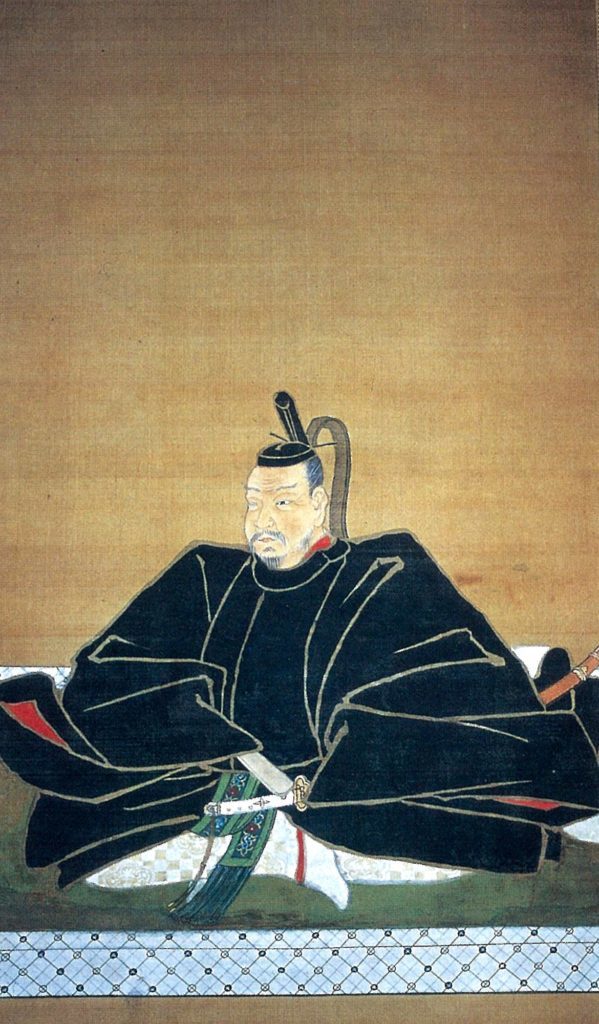
Date Masamune was a regional ruler who founded Sendai, the capital of Miyagi Prefecture. He was known as “One-eyed Dragon of Oshu“, having lost his right eye to smallpox he had as a child. In battles, he wore his well-known crescent-moon helmet, which only added to his reputation as a frightening warrior. He fought his first battle at the age of 14, fighting alongside his father in the clash against the rival Soma family. After his father’s death, Masamune became the head of the Date clan. He served shogun Toyotomi Hideyoshi who once spared his life in admiration of his bravery in the face of death, but after his death pledged allegiance to Tokugawa Ieyasu who made him the lord of the Sendai Domain and one of the most powerful regional rulers in Japan.
Tomoe Gozen (c.1157-1247)
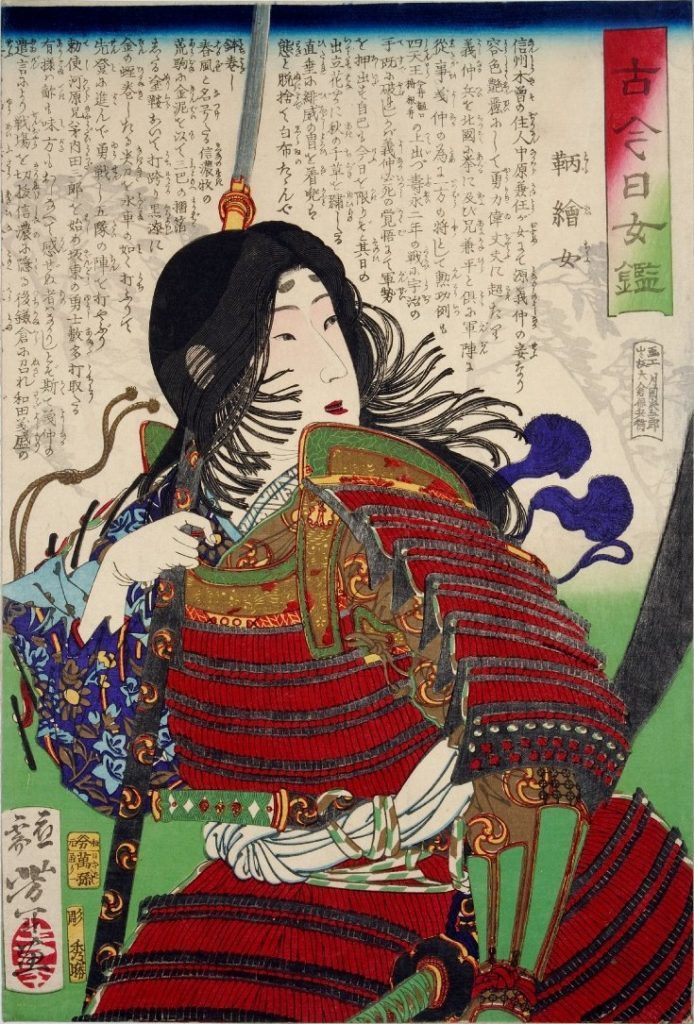
Tomoe Gozen was onna-bugeisha (female samurai), admired for her swordsmanship, bravery, and strength, in addition to her extraordinary beauty. She fought in the Genpei War alongside Minamoto no Yoshinaka, to whom she was either a wife or a mistress. Her moment of glory came in the Battle of Awazu, in which Yoshinaka was killed. Yoshinaka told her that he wanted to die fighting, and urged her to leave the battlefield because he did not want to die with a woman. There are many accounts of what happened next. According to some, she beheaded one samurai warrior and obliged by escaping the battlefield. Uchida Ieyoshi, a samurai warrior who betrayed Minamoto no Yoritomo, also died at her hands.
Uesugi Kenshin (1530-1578)
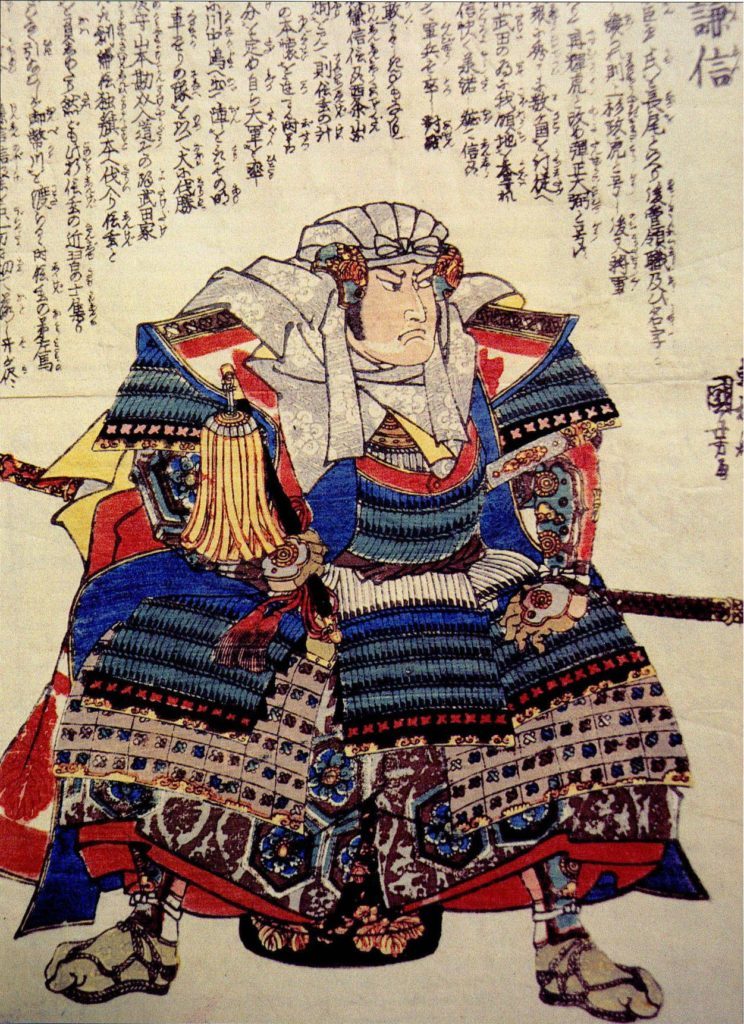
Uesugi Kenshin, born in Nagao Kagetora, was the most powerful feudal lord of the Sengoku period, along with Takeda Shingen. He was not only an exceptionally skilled warrior but also a great administrator and trader. He had a longstanding rivalry with Takeda Shingen over the province of Kanto. Uesugi took the name Kenshin (meaning new sword) and become a Zen-Buddhist, taking a vow of celibacy and becoming vegetarian. He identified with the Buddhist god of war- Bishamonten. By defeating Oda Nobunaga he managed to prevent him from taking over Japan. Kenshin either died of stomach cancer or was murdered by a ninja who was hiding under the latrine.
Ishida Mitsunari (1559- 1600)
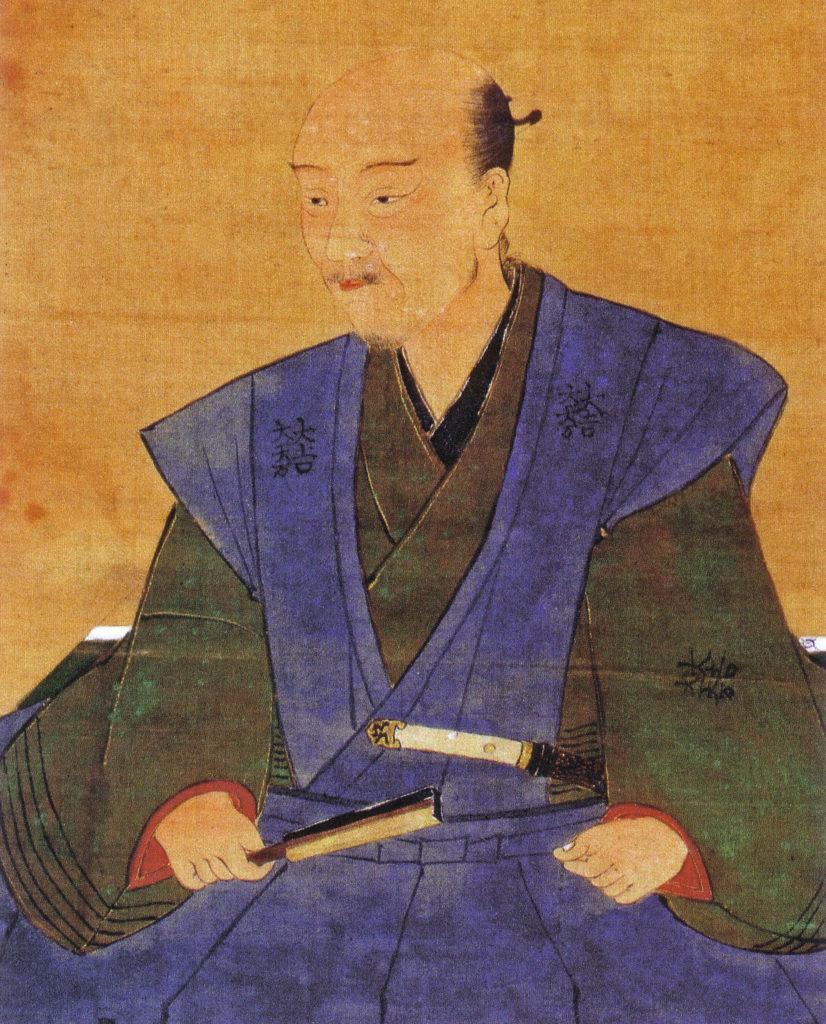
Ishida Mitsunari was the general of the Western army during the Sekigahara battle. When he was a 13-year-old boy he met Toyotomi Hideyoshi, who appointed him to his staff after enjoying three cups of tea that the boy served him. He went on to become Hideyoshi’s financial manager and administrator, in charge of diplomatic relations with foreigners, among other things. After Hideyoshi died, Tokugawa Ieyasu became one of the five rulers to rule in the name of Hideyoshi’s five-year-old son, and Mitsunari soon became disillusioned with him. He was caught by peasants and executed in Kyoto.
Kato Kiyomasa (1562- 1611)
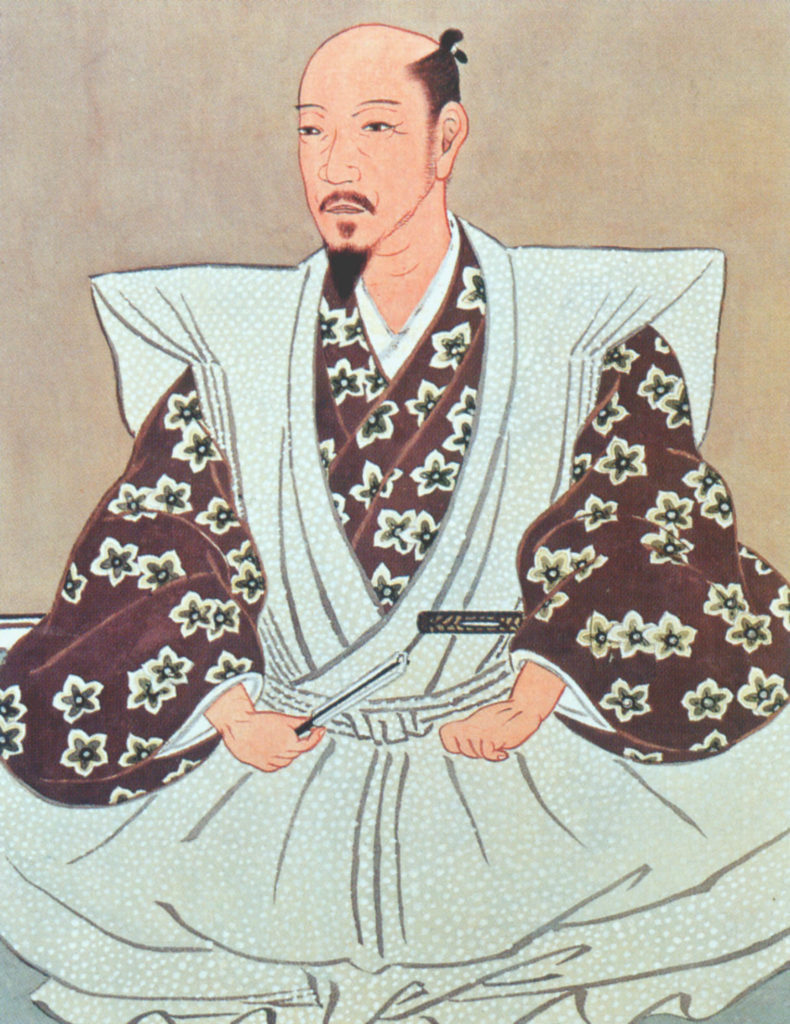
Kato Kiyomasa, was instrumental in helping Toyotomi Hideyoshi and Tokugawa Ieyasu to unite Japan. He was the relative of Hideyoshi, and fought alongside him in the Korean campaign, earning the nickname “Devil Kiyomasa“. He was one of the Seven Spears of Shizugatake, Hideyoshi’s bodyguards at the Battle of Shizugatake, and was awarded a lot of land for his service. He built a number of Buddhist shrines and was suppressing Christianity. Having acted as a mediator between Hideyoshi and Ieyasu on many occasions, Kiyomasa fell ill and died after one such meeting.
Sakamoto Ryoma (1836- 1867)
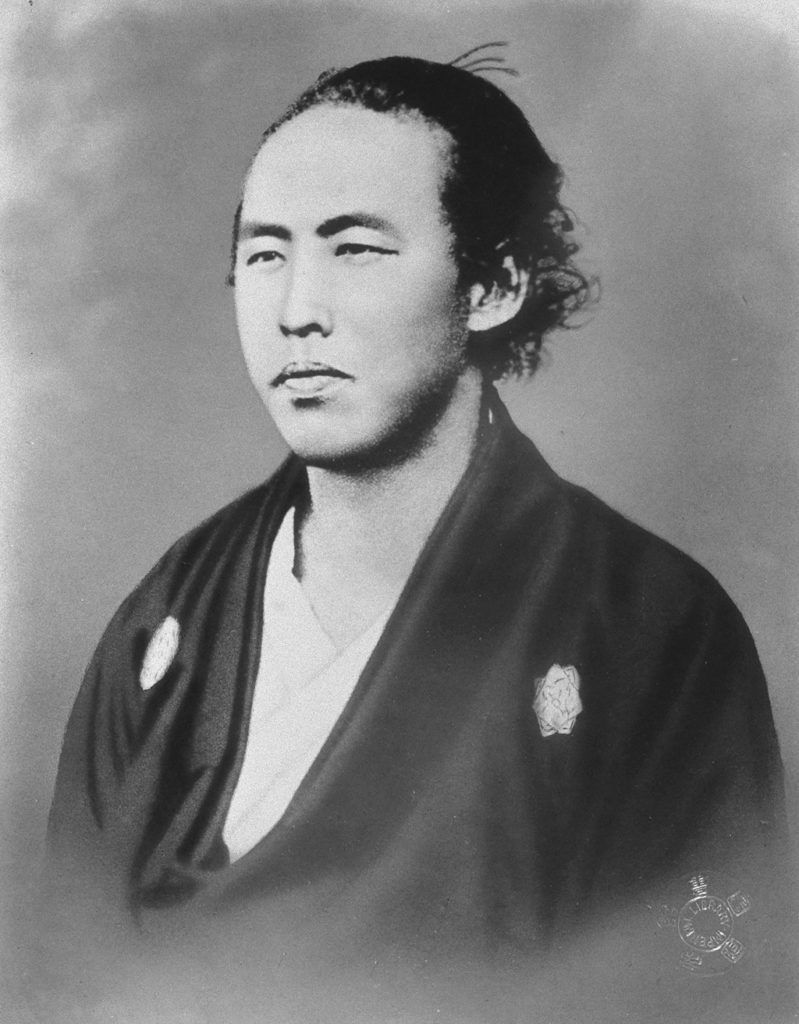
Sakamoto Ryoma was one of the most beloved and admired Japanese heroes, known as a “Japanese Che Guevara“ and celebrated in Japan’s popular culture. He fought against the Tokugawa shogunate, and was known for his visionary work and reforms striving for a more democratic Japan, based on equality. The fact that he managed to forge an alliance between Choshu and Satsuma provinces, proved instrumental in the overthrow of the Tokugawa shogunate in the Boshin war. He is also known as the “Father of the Imperial Japanese Navy“since he established the flotilla to fight against the Tokugawa. He was assassinated by a band of assassins in the Omiya Inn at the age of 31 (only a 5-minute walk from this museum. The Kochi Ryoma Airport is named after him and there is a Sakamoto Ryoma Memorial Museum in the same city.
Ito Hirobumi (1841- 1909)
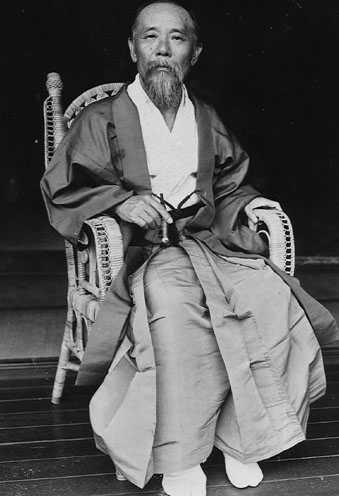
Ito Hirobumi was the first prime minister of Japan who was coming from a samurai family. He drafted the Meiji Constitution, looking up to Western models, owing to his England-based education. He became the first Prime Minister of Japan in 1885 and held the same position three more times, the longest tenure in the history of Japan. Following the Japan-Korea Treaty in 1905, he became the first Japanese Resident-General of Korea, and the President of the Privy Council of Japan, following Korea’s subsequent annexation. He was murdered at the Harbin Railway station, by a Korean nationalist and independence activist.
Hijikata Toshizo (1835- 1869)
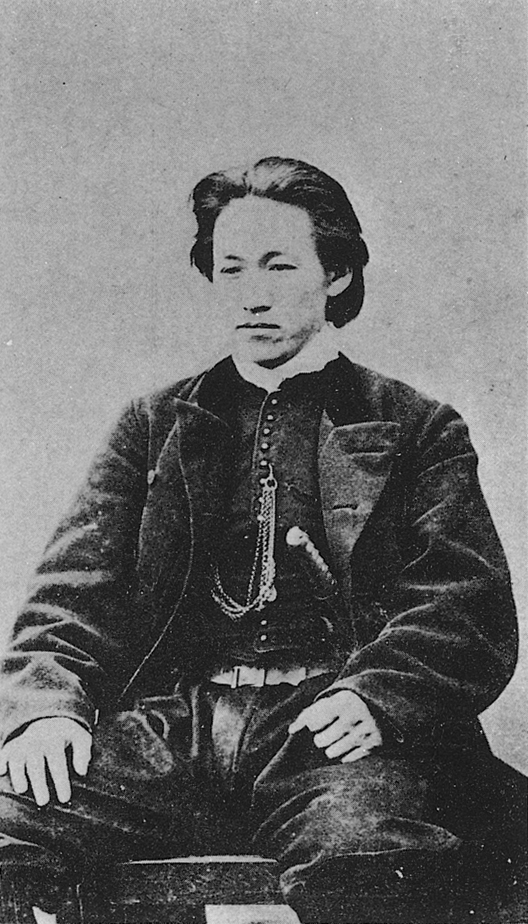
Hijikata Toshizo born into a wealthy family in Musashi went on to become the vice-commander of the Shinsengumi. He was practicing kenjutsu when he met Kondo Isamo, the fourth master of the Tennen Rishin-Ryu martial art, and became his disciple. He fought alongside his teacher at the Battle of Toba-Fushimi and replaced him at the Battle of Yodo-Senryomatsu, because Kondo was wounded. It is said that, after having lost many men in these battles, Toshizo realized that he would no longer have any luck in battles. After Kondo’s death, Hijikata announced the new “Republic of Ezo“. He was killed in the final conflict with the Imperial Forces while riding on horseback in combat.
Akechi Mitsuide (1528~1582)
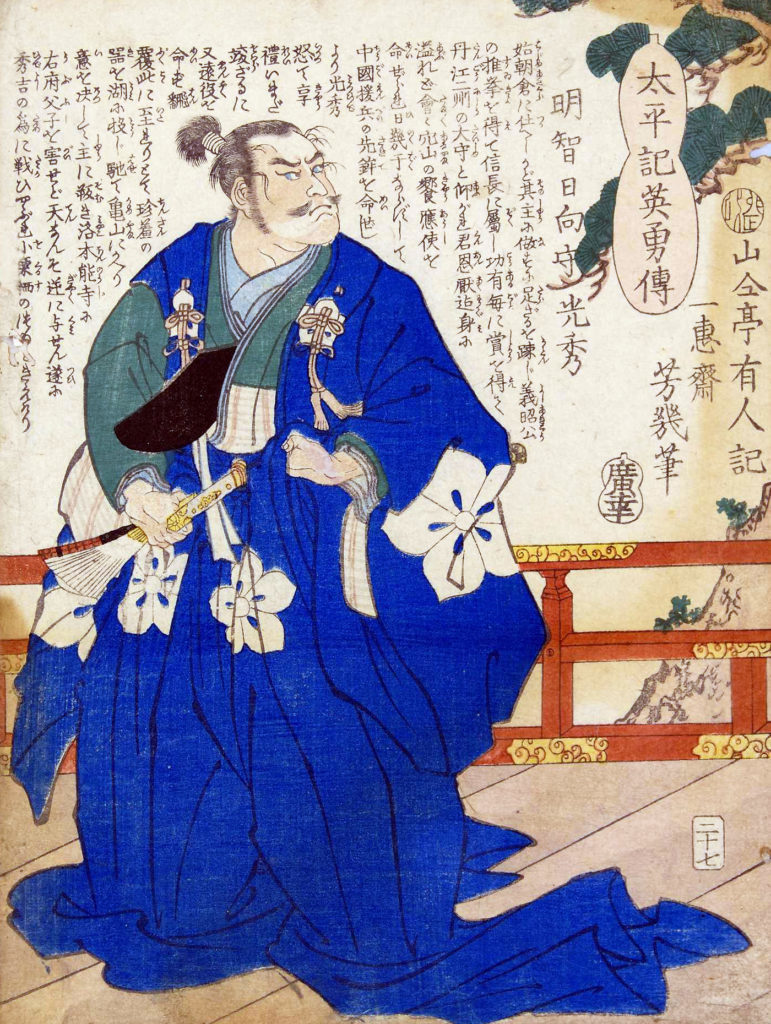
Akechi Mitsuide was a daimyo of the Akechi clan and a general under Oda Nobunaga. He betrayed his master Nobunaga and ordered his troops to kill him. Soon after he was killed by a ronin and Toyotomi Hideyoshi started ruling Japan. Although this kind of betrayal is uncommon some say he was infuriated because Nobunaga insulted him publicly and Nobunaga killed the rulers of a major clan who in turn kidnapped Akechi’s mother and killed her.
Kondo Isami (1834- 1868)
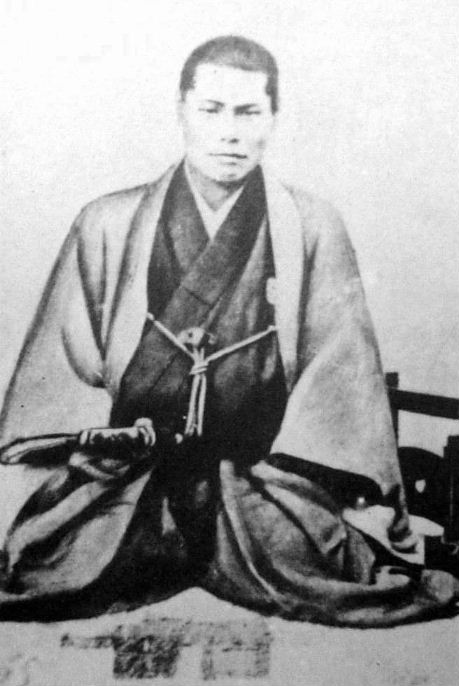
Kondo Isami was a swordsman and a renowned commander of the Shinsengumi. He was adopted by Kondo Shusuke, master of the Tennen Rishin-Ryu (Japanese martial art practiced by the Shinsengumi), who was impressed by the bravery of then a 13-year-old boy who saved his family home from a group of thieves. Isami went on to become the fourth master of the Tennen-Rishin-Ryu. He was wounded at the battle of Toba-Fushimi and nearly escaped the Imperial Forces at the Battle of Koshu-Katsunuma. He was finally caught by surprise during training in 1868, arrested by the Imperial Forces, and beheaded at the Itabashi execution grounds. His head was put on public display, but it was stolen and buried behind an ancient shrine in Okazaki.
Saigo Takamori (1828- 1877)
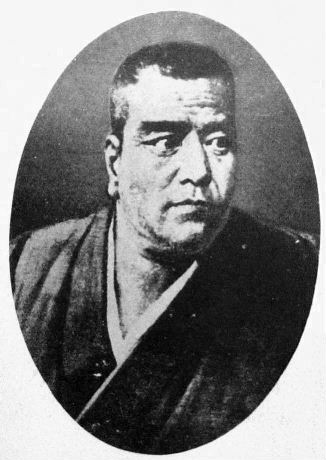
Saigo Takamori, known as the last true samurai, resisted modernism and is hailed as a national hero in Japan. When he was a young man, his master died, and he, wanting to follow an old tradition of junshi, attempted to commit suicide by jumping into a lake, but survived. When Japan was forced to sign the Treaty of Kanagawa and open its ports to American ships under the command of Commodore Matthew Perry, it ended Japan’s 220-year-old policy of seclusion (sakoku) and exposed the weaknesses of military dictatorship (shogunate). This event triggered the Meiji Restoration, with Emperor Meiji attempting to modernize the country and dismantle the old system of rule. When the reforms threatened the samurai way of life, forbidding them from carrying their swords in public, ordering them to wear their hair in Western fashion, Saigo resigned from his government positions and established his own school, attracting as many as 20.000 young samurai. From there, he led the Satsuma rebellion against the central government. Details surrounding his death during the rebellion are not completely known, but it is believed that he committed seppuku, either by himself or assisted by another samurai.
Foreign Samurai
Several people from foreign countries were considered and were given the title of samurai. The majority of them were brought to Japan as prisoners or allies, serving daimyos as retainers.
After the Japanese invasions in Korea during the Joseon Dynasty, many Korean natives were brought to Japan and were put under the service of the daimyos.
One of the most notable figures was Kim Yeocheol, who served under the Maeda clan in the early Edo Period. He was even given the Japanese name Wakita Naokata and made the Commissioner of Kanazawa City.
Dutch native, Jan Joosten van Lodensteijn and English Navigator William Adams were two of the first Westerners to receive the title of the samurai in Japan, care of shogun Tokugawa Ieyasu, giving them high-prestige positions serving as retainers under the shogunate court.
Yasuke was a black samurai of African origin (from Ethiopia, Mozambique, or South Sudan), described as being a foot taller than other men of his time and “having the strength of ten men“. He was brought to Japan in 1579, by Jesuit missionaries and made a bodyguard to Oda Nobunaga. Upon seeing him for the first time, Nobunaga found it hard to believe that his skin was really black, so he asked him to take his shirt off and scrub his skin to prove that it was not ink. Yasuke’s career as a samurai ended when Nobunaga committed seppuku (ritual suicide), after being defeated by his former general Mitsuhide.
History of the Samurai
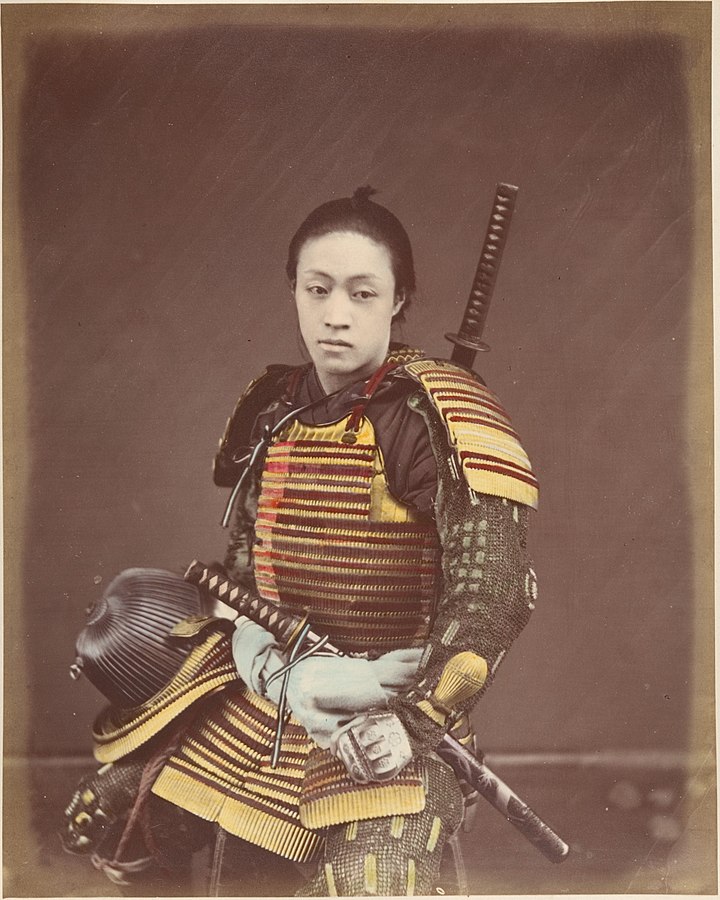
The first mention of the samurai in Japanese history was in the 8th century when Japanese culture as we know of it today was just being developed. At the time, the samurai weren’t considered warriors but were more of lower power bureaucrats, before they rose to power centuries later as the head of the country’s first military dictatorship known as the shogunate.
The Battle of Hakusukinoe
During the Asuka and the Nara period (538-784), Japan underwent a widespread reformation after the decisive loss during the Battle of Hakusukinoe, against the allied forces of the Korean Silla military and the medieval Tang Dynasty of China.
One of the most important, with regards to the early establishment of the samurai, was the Taika Reform in 646. This edict prompted the Japanese aristocracy to follow the structure of the Tang Dynasty in terms of politics, bureaucracy, culture, religion, and philosophy.
The Taiho Code in 702, and later the Yoro Code, the population of Japan was required to regularly report for a census, a precursor to national conscription, as a way to keep track of the nation’s population.
Requisite drafting was later introduced from this census, as a way to build a military force, following the Chinese system. These conscripts were required to procure their own weapons and in exchange were exempt from duties and taxes. This conscription method was short-lived, according to historians.
The code classified bureaucrats into 12 ranks, with the first and highest ranks serving close to the emperor. The lower ranks, starting from the 6th, were called the samurai and took care of daily affairs as public servants. The military aspect of the samurai did not emerge until centuries later.
It wasn’t until the Heian Period (794-1185) when the samurai exercised their political arm in order to control and subdue the native Emishi people in the Tohoku Region.
The Emishi Rebellions
Emperor Kanmu, during the late 8th and early 9th century, wanted to solidify his rule and expand beyond the Honshu region, instigating the campaigns against the Emishi, an ethnic group who inhabited the deep northernmost part of Honshu.
The Emishi were strongly against the Imperial ruling of Japan and resisted the court at the time, not unlike their media representation in the Studio Ghibli film, “Princess Mononoke.”
The temporary title of sei’i taishogun or shogun was introduced, meaning “Commander-in-Chief of the Expeditionary Force Against the Barbarians”, which from its name itself were established as a way to deal with the rebels. The shoguns were composed of skilled clan warriors from different regions who were tasked with conquering the ethnic group, and eventually became the emperor’s main tool for pacifying rebellions against the Imperial ruling.
The title of shogun did not have any political power until the 13th century, and until then were simply a part of the military arm of the Imperial court.
Emperor Kanmu eventually started losing power over his rule. At this time, powerful clans around Imperial Kyoto took on the positions as ministers, with relatives taking over as magistrates under their ruling by buying the title.
The corruption brought on by the magistrates to hoard wealth and settle debts was deeply rooted in the heavy taxes placed upon the peasants, especially farmers who would end up losing their lands to pay their due.
These aristocrats garnered political power with alliances and arranged marriages, eventually exceeding the kuge, or the traditional aristocratic class that dominated the Kyoto Imperial Court.
Clans were eventually formed by the farmers in order to protect themselves and the land from the magistrates and overtaxing, as well as from more powerful clans. The farmer clans then adopted the use of armour and weapons like the tachi to strengthen their power during the mid-Heian Period.
The Hogen Rebellion
The domination of the samurai began around 1160 during which one of three powerful regional clans in conflict, the Taira, gained more control over the Minamoto and Fujiwara. The samurai started rising in power during the Kamakura Period (1185-1333) under the shogun rule where they were tasked with the security of the daimyo estates, as well as served as the symbols of the perfect warrior and citizen.
Even though the samurai were initially hired by the emperor and other nobilities, they gathered enough influence and resources to establish alliances that gained them political power and dominated the government, turning the emperor’s position into something merely symbolic.
This rise in power proved to be useful for its influence over the Imperial Court, further consolidated by the results of the Hogen Rebellion– a short civil war within the Fujiwara clan that was meant to resolve a dispute among the Imperial succession between those loyal to Emperor Go-Shirakawa and the retired Emperor Sutoku, as well as clan dominance over the Imperial ruling during the Heian Period.
The Hogen Rebellion (1156) created the foundation of a samurai-controlled government and began a chain reaction in the samurai ruling over the course of history in Japan.
The Heiji Rebellion
The Heiji Rebellion followed just four years after the previous civil war in 1160. The dispute was between two rival clans, the Taira and Minamoto, as a struggle for power.
This rebellion was sparked from the abdication of Emperor Go-Shirakawa, leaving the title to his eldest son but with no cession of political powers of any kind. This meant that despite being enthroned, Emperor Nijo had no control as all the affairs were still being managed by his father, Go-Shirakawa.
The Taira clan emerged as the victor in the rebellion, with Taira no Kiyomori becoming an imperial advisor, and the first warrior to be given the position. The central government eventually moved to be under his control, reducing the emperor into a figurehead.
The Taira clan, however, was more conservative and established its control and power by marrying their women to emperors and successors and turning them into puppets.
The Genpei War
Another power struggle began between the Taira and the Minamoto clans, sparking the Genpei War (1180-1185), resulting in the downfall of the Taira and the dominance of Minamoto no Yoritomo under the establishment of the Kamakura shogunate, and its superiority over the aristocratic court.
Morimoto no Yoritomo appointed himself as the Sei-i Taishogun in 1192 but instead of setting up his ruling in the Imperial capital of Kyoto, Morimoto no Yoritomo set up his shogunate in Kamakura, hence the name of the period.
The Genpei war made way for Yoritomo to create the right to appoint shugo, a type of constable, and jito, a territory steward who manages estates and national holdings under the provincial governors. They were also allowed to organize soldiers and collect a set amount of tax.
Although their responsibilities were to initially keep rebels in line and collect provisions to maintain the army, this gradually expanded over time.
The Mongol Invasion
As various other samurai clans struggled over power and influence during the 13th century in the Kamakura Period, Zen Buddhism began its spread among the warriors, greatly influencing their discipline and way of life– particularly the well-known traits of being unafraid of death and killing.
Around the same time, the Chinese Yuan Dynasty launched an attack to invade Japan in 1274 on the northern part of Kyushu island, following their victory over the Korean kingdom of Goryeo. Japan managed to come up with just about 10,000 samurai to deal with the threat against 40,000 Chinese warriors and their large armada.
Despite the great disadvantage in numbers, the Japanese were able to successfully defend their territory with the help of the furious thunderstorms that continuously exhausted the invading forces and inflicted heavy casualties.
The initial Mongol invasions prompted the construction of the Genko Borui, a defensive stone wall, around Hakata Bay. Since then, diplomatic envoys were sent to Japan from 1275 to 1279 to settle the conflict but each one was executed.
This continuous harsh defiance against the Mongol emperor sparked one of the most famous clashes in Japanese history.
A Yuan army of 140,000 soldiers and 5,000 ships were set for the second invasion of Japan in 1281, with northern Kyushu being defended by a mere 40,000 samurai. Again, this imbalance in forces meant nothing as another typhoon hit Kyushu island as the Yuan ships were still preparing to reach land. A large number of casualties from the storm, as well as the defense in Hakata Bay resulted in another retreat from the Mongols.
These two events in 1274 and 1281 contributed to the samurai legends that they were blessed with the “kami-no-kaze” or “the wind of the gods”. This incident also strengthened the Japanese belief that the country was under divine and supernatural protection.
During the period of the Mongol invasions came forth the development of the Japanese art of swordsmithing, which involved combining layers of soft and hard steel to produce a blade with a very hard but brittle edge– the beginnings of the Japanese swords tachi and katana.
The Warring States

The samurai during the Muromachi Period
From 1467 to 1615, Japan was in a near-constant civil war, spurred on by the Onin War, also known as the Upheaval of Onin, during the Muromachi Period (1336-1573).
The Onin War dispute started over the succession of Ashikaga Yoshimasa after he named his brother, the monk Ashikaga Yoshimi, as his heir and the unexpected birth of Yoshimasa’s son, Yoshihisa.
The birth of the child caused a conflict between supporters, with the mother, Hino Tomiko, seeking to rule as regent through political and military power by securing the support of powerful samurai clans and Yamana Sozen. Ashikaga Yoshimi, however, has the support and backing of the Hosokawa, another powerful clan with influence over the shogunate court.
This dispute led to the collapse of the feudal system in Japan under the Ashikaga Shogunate and marked the beginning of the Sengoku Period, or the Warring States Period.
Many samurai warlords and clans struggled for control over Japan in the following 147 years, giving birth to the Ikko-Ikki, a diverse group of people that were formed over the many regions in Japan to oppose the rule of the daimyo and the samurai. This rebel group consisted mainly of the common folk such as peasants, priests, merchants, and the like, who believed in the Jodo Shinshu sect of Buddhism, or “True Pure Land Buddhism”.
As the samurai culture at this time was becoming loose in discipline and standards, many people from outside the warrior caste sought to make a name for themselves as warriors and became masterless samurai who were eventually called ronin.
It was also during this period in Japanese history where war tactics and technology rapidly developed and improved, aided by the introduction of the European arquebus, a type of long gun. This weapon and its mass production by the Japanese became a critical turning point in the Sengoku Period, with thousands of firearms being made and used in battles, the most notable being that of Oda Nobunaga.
The Reunification and the Tokugawa Shogunate
The ongoing conflict in the country was brought to heal by the Three Unifiers of Japan who were known to have contrasting personalities which were often expressed by three well-known senryu series or a short poem to describe their characters and personalities.
| Oda Nobunaga |
Nakanu nara
Koroshite shimae Hototogisu |
If the cuckoo does not sing, kill it |
| Toyotomi Hideyoshi |
Nakanu nara
Nakasete miyo Hototoogisu |
If the cuckoo does not sing, coax it |
| Tokugawa Ieyasu |
Nakanu nara
Naku made mato hototogisu |
If the cuckoo does not sing, wait for it |
Oda Nobunaga was a daimyo of the Owari Province, now Nagoya, a great samurai during the Sengoku period, and is regarded as the first Great Unifier of Japan. Nobunaga was the head of his family and the Oda clan in 1555.
His leadership initially splintered the Oda clan after usurping and killing the last head, his uncle. The divide in the clan was short-lived, however, as he was able to dominate over the other groups and gain control over Owari. After which, he turned to reign over rival clans in the area, leading to the collapse of the Ashikaga Shogunate, some of which are:
- Imagawa
- Saito
- Azai
- Asakura
- Takeda
Oda Nobunaga made great contributions in the field of organization and war tactics in Japan, assimilating the wide use of arquebuses, as mentioned in the previous section, as well as the development of commerce and industry.
By 1582, Oda Nobunaga became the de facto leader of Japan and the most powerful warlord among the clans but was betrayed by one of his own generals, Akechi Mitsuhide during a tea ceremony.
To prevent Mitsuhide from acquiring his decapitated head after Nobunaga performed seppuku his page, Mori Ranmaru, set the temple on fire. This act had Ranmaru go down in Japanese history for his loyalty and devotion.
The second Great Unifier of Japan, Toyotomi Hideyoshi initially served as Oda Nobunaga’s sandal bearer. Hideyoshi’s rise to power can be attributed to his successful efforts in negotiating submission and service to Nobunaga by other clans and warlords, eventually becoming one of Nobunaga’s most distinguished generals.
After the betrayal of Akechi Mitsuhide that caused the deaths of Oda Nobunaga and his son, Nobutada, Hideyoshi sought revenge for the death of his friend and lord at the Battle of Yamazaki, where he emerged victoriously. He gained the same power as Nobunaga, became a grand minister in 1586, and created a law that prohibits non-samurai from carrying weapons.
This law helped distinguish the samurai and the common folk, keeping weapons within clans and families– one of the reasons why legendary swords like the katana are passed down through generations in the same family.
Hideyoshi continued to launch campaigns to establish dominance and pacify rebellions with his new powers, along with his alliance with Tokugawa Ieyasu, even launching campaigns to invade China through Korea, in what was known as the Imjin War.
Toyotomi Hideyoshi met his death in 1598 during the second invasion attempt of Korea, where it was said that he was delirious. The Council of Five Elders, formed by Hideyoshi shortly before his death, kept his death a secret to preserve morale before recalling the soldiers back to Japan. These failed attempts left Hideyoshi’s clan weakened when Tokugawa Ieyasu started to dominate.
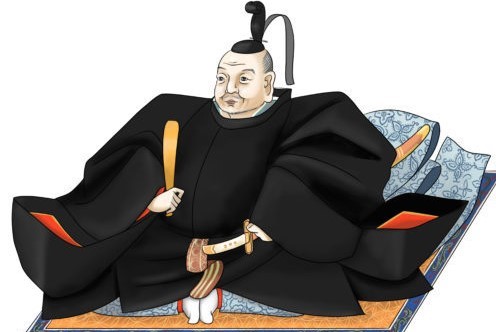
Tokugawa Ieyasu was the first shogun and the founder of the Tokugawa Shogunate, which governed Japan during the Edo Period from 1603 to 1868.
After Hideyoshi’s death, Ieyasu was quick to take control of the Toyotomi clan. The struggle for power among the daimyo led to one of the biggest and most important battles in Japanese feudal history, the Battle of Sekigahara, which preceded the establishment of the Tokugawa shogunate, the last shogunate to control Japan.
Under the Tokugawa shogunate, Ieyasu established a political system called the bakuhan, which gives the shogun national authority and the daimyo with the regional authority. This efficient system in the feudal structure of Japan brought on 250 years of stability.
The Bakumatsu
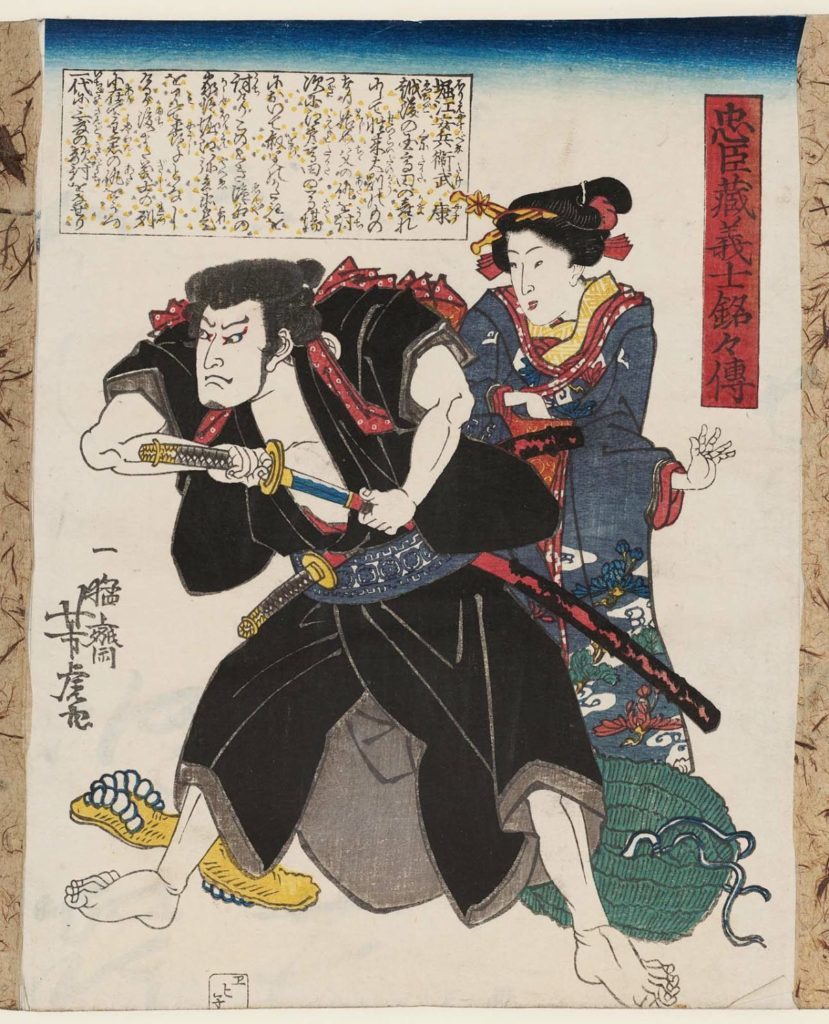
The term “bakumatsu” is used to refer to the later years of the Edo Period, or the end of the Tokugawa Shogunate. The fall of the samurai-dominated government was brought on by the unrest among the tozama daimyo or outside lords, and the pressure of Western powers.
At the time, the shogunate was hesitant and wary of outsiders, with only a few harbor towns dealing with trade with Western merchants. This period of isolation from foreign trade was called sakoku, and faced major change with the coming of the Meiji government.
The Meiji restoration sought to modernize Japan and to dissolve the entire samurai class and instead integrate them into the modern age– professionals, military, and business classes, as the traditional samurai held too much power, monopolizing the military strength as well as a large portion of the country’s education.
These former samurai were then called Shizoku (a status that existed from 1869-1947) or warrior families and held no special class privileges, effectively making them commoners save for the title on government papers.
While other samurais formed rebellions after their dissolution, younger members often went abroad to continue their studies. These younger samurais effectively started schools and universities on their return to Japan, as well as starting their own companies or entering the government.
By the start of the 1900s, the most prominent Japanese businessmen were from the samurai class, and many of their founded companies still stand today– one of which is Mitsubishi, which was started by Japanese industrialist Iwasaki Yataro, a former member of the samurai warrior nobility and a part of the Iwasaki branch of the Takeda clan.
The Bushido Code
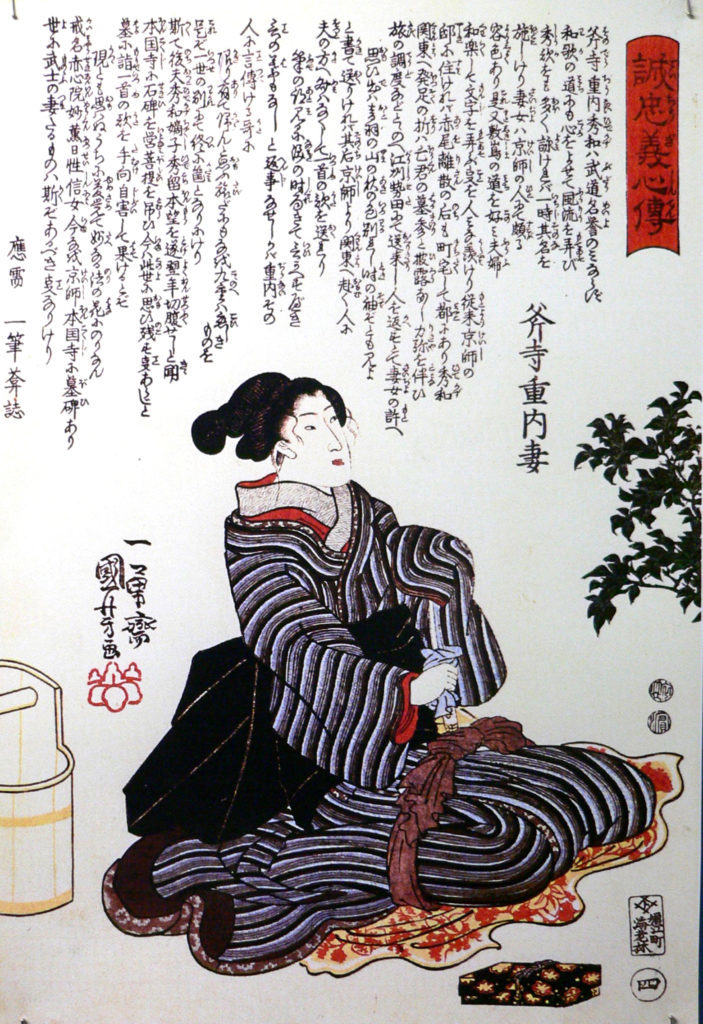
Female samurai seppuku
The Japanese, not excluding the samurai, followed Zen Buddhist teachings and the native animist faith of Shintoism. Samurai culture was also influenced by Confucianism.
The main influence of Buddhism in samurai culture was evident in the mental discipline practiced by warriors, which in turn created the Bushido Code.
“Bushido is realized in the presence of death. This means choosing death whenever there is a choice between life and death. There is no other reasoning.”
– Hagakure, The Book of the Samurai by Yamamoto Tsunetomo.
Bushido, or “the way of the warrior”, is a set of moral codes that dictates the behavior and lifestyle of the samurai. Although there are many forms of bushido that are still used in modern-day Japan, the term is commonly used to refer to the practices, philosophies, and principles of the samurai.
The placement of the Bushido formalized earlier values observed by the samurai, putting emphasis on the combination of sincerity, loyalty, discipline, and honor until death– commonly observed by the samurai committing seppuku, an act meant to regain or keep honor in tact in the face of capture or capital punishment.
The Bushido branched out from Confucian texts during the Edo period or the Tokugawa Shogunate, while also retaining influence from Shintoism and Zen Buddhism.
Although others would claim that the ethical codes took form in the Heian and Kamakura Period when the warrior caste rose in power.
Weapons and Armor
Samurai warriors were known to be experts in multiple weapons such as swords and the bow and arrow. However, there’s more to it than just wielding the katana.
Although brandishing real weapons in modern-day Japan is not recommended, samurai experiences can be found all over the country where people will be able to see what it was like for the samurai back in the day.
The Samurai & Ninja Museum is a leading samurai museum in Japan that offers a variety of experiences that inform and educate visitors on the history and relevance of samurais and ninjas in Japan. Some of these experiences will range from sword cutting, historical tours in Kyoto, and a crash course on ninja training, for kids and adults alike.
Katana

Antique Japanese Katana by Emmanuel H.
The katana is one of the most well-known historical weapons. If you don’t know much about it, you probably would have at least heard about it. Katanas are considered a collectible item because of the history behind their use from around 150 to 400 years ago.
Katanas are traditionally made with a type of special Japanese steel called tamahagane. This, combined with the laborious smelting process behind one katana results in a tough weapon with a sharp edge.
Katana or the uchi-katana was a weapon designed to stab or thrush in the Muromachi and Edo Period. It is relatively shorter than the tachi and was used for ground fighting, challenges, and to carry out the law by the samurai.
In feudal Japan, high-quality katanas are often gifted by lords to their subordinates as a token for achievements during the war. These Japanese swords are regarded today as works of art and great craftsmanship, making the katana the most famous and sought-after item–some of which are considered national treasures.
The Samurai & Ninja Museum offers samurai experiences for those who want to learn more about the katana, how to make them, and even learn how to use them.
Tachi

Tachi – Hyougokusan style sword mounting by Kakidai
Tachi would often be used to refer to longer, more curved swords. These are the weapons used by armored samurai on their horses during the Heian and Muromachi Period. This kind of sword is older and holds a more prominent curve. These antique swords were once believed to house spirits that guide and protect their individual samurai.
Wakizashi

Edo Period Wakizashi by Chris 73
Wakizashi is a short blade that measures about 30-60 cm and was designed for close combat or in small rooms. These smaller weapons served as a form of protection for samurai when entering castles where katanas are prohibited. The wakizashi became more prominent in the Edo Period when samurai were required to wear a katana and a wakizashi to identify themselves as military personnel and officers.
Tanto

Tanto
Tanto is a shorter blade in comparison to the wakizashi and was used as supplemental weapons as well but to samurai riding horseback for when they have to fight in close combat in the Kamakura and Muromachi Period. Tanto blades were often given as gifts to brides at a traditional Japanese wedding, as it was believed to provide sacred protection and ward off evil spirits.
Yumi
Although is the Japanese term for bow, it is more commonly used to refer to the traditional Japanese asymmetrical bows such as the daikyu, a longbow, and the hankyu, the shorter bow. These weapons were used in the kyudo and kyujutsu practice– Japanese archery. These bows were distinct as they were an impressive height, usually taller than their archer.
The samurai were skilled bowmen who wielded these weapons during battles on horseback, preferring it during disputes as it allowed them to pick off enemies from a distance in larger groups.
Yari
The yari took a form similar to a spear or pike, and is characterized by a straight blade that would vary in length, from just a few centimeters to 3 or more feet. The blades are made the same way as traditional Japanese swords, with variations like protrusions along the flat side. These blades are mounted on very long shafts, which would vary in decoration and length.
The yari became more popular than the yumi amongst the samurai and the ashigaru as they were easier to use to push back against tight enemy formations and keep a distance. If you’ve played Total War: Shogun 2, you’re most likely to use the Yari Samurai as a defensive unit against cavalry– however, they were vulnerable against ranged attacks like matchlock units or tanegashima.
Tanegashima
The tanegashima or matchlock gun is the Japanese version of the European arquebus which was introduced to Japan in 1543. The introduction of the tanegashima proved to be a critical turning point in the history of the samurai, with Oda Nobunaga utilizing the firearm for his armies during the Sengoku period, gaining him the upper hand in many battles.
Unlike the European arquebus, the Japanese refined and used various techniques that improved the gun, even incorporating a staggered firing technique that triggered a series of bullets to be fired continuously.
Samurai Armor
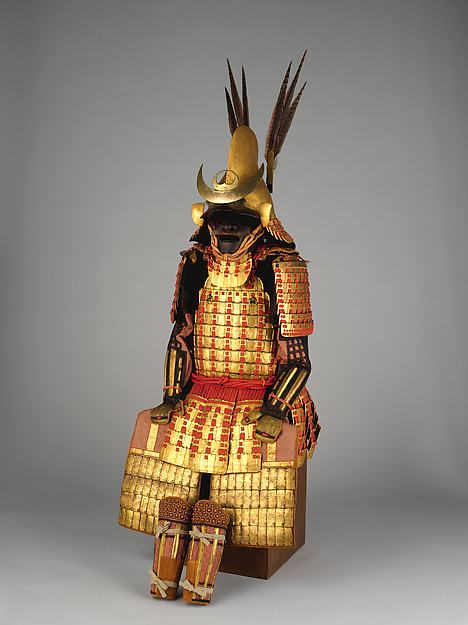
Japanese armor, according to scholars, appeared around the 4th century, and appeared to have originated from China through Korea. Earlier versions of the armor resemble that of the neighboring countries until it evolved to its distinct, boxier shape with decorative pieces that were meant to intimidate during battle.
Traditional armor which was worn during battles soon became unnecessary during the peaceful Edo Period, creating the more lavish armors that served as a status symbol for high-ranking samurai generals. However, lightweight and more hidden armors became common as a form of personal protection, not unlike a modern bullet-proof vest.
The Samurai & Ninja Museum also offers the opportunity to wear samurai armor and use a sword in their tours!
The Samurai & Ninja Museum
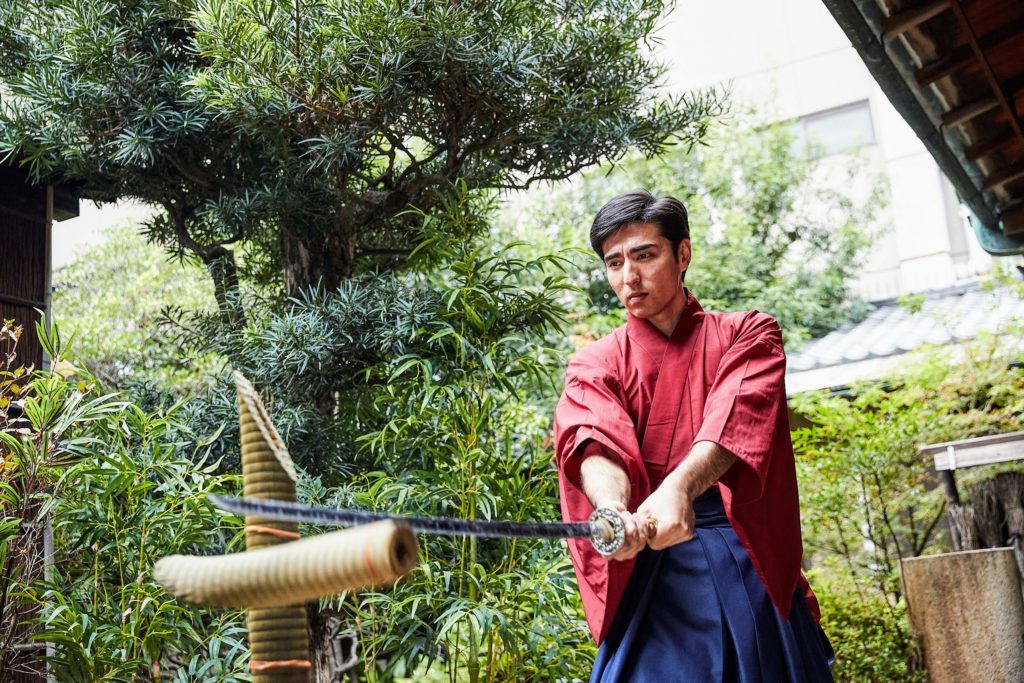
samurai sword cutting
Although the samurai no longer exist in modern-day Japan, there are many exhibits and establishments that offer the unique experience of learning about them more intimately. The Samurai & Ninja Museum Kyoto is a leading samurai museum in Japan that offers visitors the opportunity to learn about samurais and ninjas in Japan, from sword cutting, historical tours in Kyoto, and a crash course on ninja training.
This article was prepared by the Samurai & Ninja Museum Kyoto staff. Come visit us to learn more about the samurais in Japan’s history and culture!
Check out all the exciting activities you can do with us:
- Samurai Sword Experience for Kids and Families (Ninja experience and Museum Tour included)
- Kyoto Samurai Walking Tour at Samurai and Ninja Museum Kyoto
- Interactive Samurai Museum Experience + Kyoto Style Kimono Tea Ceremony at Maikoya
- Samurai Sword Cutting Experience in Kyoto: Tameshigiri
Contact us : info@mai-ko.com





